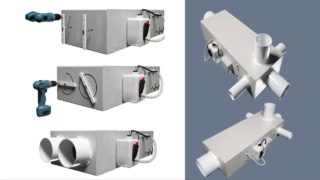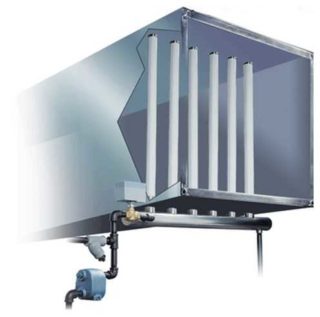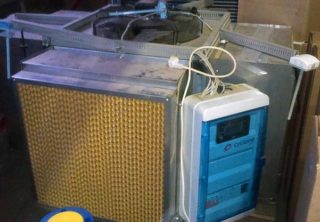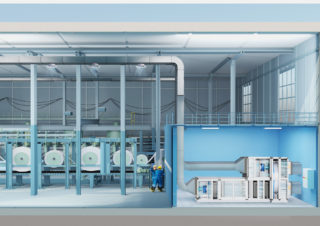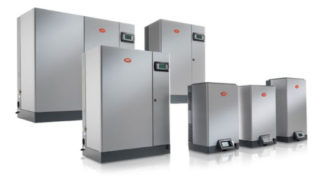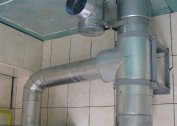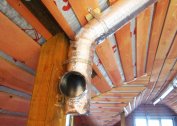A duct humidifier can be mounted in an air heating circuit or an exhaust hood for ventilation. It is used to control humidity in spacious rooms. The device is highly efficient and easy to use.
The principle of operation and types of channel humidifiers
If the usual household appliances are installed separately, then this humidifier in the ventilation system is mounted inside the channel. When air enters the device, it is saturated with moisture. Then, through the ventilation course, he goes to the room. When connected to internal air, the average humidity level rises.
There are several types of duct humidifiers that differ in their internal structure. For installation, choose the model that is most suitable for the structure of a particular ventilation system.
Adiabatic humidifiers
These devices generate moist mist with small droplets, which then evaporates in the supply air stream. Water spray can be produced by different devices, for example, an atomizer; the most popular option is an ultrasound emitter. Install this device directly into the supply air duct.
During operation of a channel ultrasonic air humidifier, a halo is formed around the atomized device from suspended fine particles of moisture. The flow moves them through the air duct, the liquid evaporates and saturates the atmosphere along the way. Once in the room, this air is mixed with the circulating inside. During the operation of the technique, there is no accumulation of condensed moisture on the channel walls.
The body of the device is made of anti-corrosion steel. In addition to the membrane atomizer, there is also a water tank and an electronic control module inside. The device is mounted on the flanges in the duct.
In order for a device working with ultrasound waves to last longer, it is advisable to fill it with minimal mineralization. If this is not possible, before filling the tank, the liquid is filtered through a reverse osmosis device. This will minimize clogging of the internal paths.
Steam devices
A steam humidifier for ventilation serves the air ducts. It distributes dry steam over them from the main steam supply unit. From the last supply pipes go to the filtering device. On them is the supply of steam. Having overcome the valve, they are sent to the supply pipe and from it move to the collector distribution devices mounted in the inflow path. As a result, the air masses enriched with steam are sent to the serviced room or production room.
Some steam units are equipped with additional functional systems, for example, the option of catching drops. At the same time, the fluid enters the collector, then to be used again. Such a function helps to reduce water costs for humidification. Steam humidifiers are found with collectors coated with a special insulating composition. This treatment reduces the amount of condensation that occurs when steam is passed through the device.
Cell humidifiers
The functioning of this type of technique is based on the evaporation of liquid from the surface of the cassette that it has saturated from a material with pronounced absorbent properties. These devices are one of the simplest devices for humidifying the air.They are also called evaporative.
Cases are made of stainless steel. A shallow liquid container is mounted inside. The latter enters the apparatus from the main channel. The pump pumps water from the tank, directing it through a special comb into the unit, which provides wetting of the cassette material. The liquid that could not be adsorbed is sent back. When an air stream passes through the cassette, water from the surface passes into a vaporous state. In this way, an increase in humidity is achieved.
The amount of liquid in the tank is monitored by a special sensor. It can be magnetic contact or float. Many humidifiers of this type have the function of draining the discharge of used water. This is necessary to control the salt content. Used cassettes are needed to be updated as they work out the resource.
Since the hygroscopic material is cooled during the evaporation of water, in hot weather this device can be used as a conditioning device. This method is also good in that it eliminates the supersaturation of air masses with moisture.
Advantages and disadvantages
The main advantage of the device is its significant efficiency. If stationary humidifiers of the usual type work in urban apartments, then this device, due to its high performance, can be used to service spacious rooms of a commercial, household or industrial purpose. The device is easy to install in the ventilation duct and carry out its maintenance. Due to the simple design, breakdowns rarely occur (this is most true for cellular devices).
The downside is that some devices generate a fairly high level of noise during operation. This limits their scope. When purchasing a humidifier, you need to find out how noisy this or that model is. It is also advisable to clarify the requirements for the quality of water poured into the device - sometimes in order to achieve compliance with them, the liquid must be pre-filtered.
Ducted climate technology is used to maintain certain humidity indicators in different types of rooms. Fans serve greenhouses, food storage rooms, warehouses. Install them in production facilities of various kinds. The device can be used in a private house.
Popular manufacturers
The Russian consumer has the opportunity to choose a device of any of the main types for industrial or other needs. Examples of models:
- Cyclone HCUC and HCU are cellular surface models for rectangular ventilation ducts. Easy to install, can be used in typeset ventilation. At the same time, they consume little power, which is especially true for the HCUC model (60 W).
- Ultrasonic device Ultrasonic from the manufacturer AquaAir. Recently, devices began to be assembled, including at Russian factories. Prior to this, production was conducted in China and Italy.
- Carel steam units are from Italy. Often they are mounted in grocery stores, in rooms where fruit and vegetable products are stored.
More often on sale devices are designed for a rectangular ventilation duct. Round-trip appliances are rare.
Duct ventilation devices are easy to install, have high efficiency. This allows them to be used for servicing large rooms.
